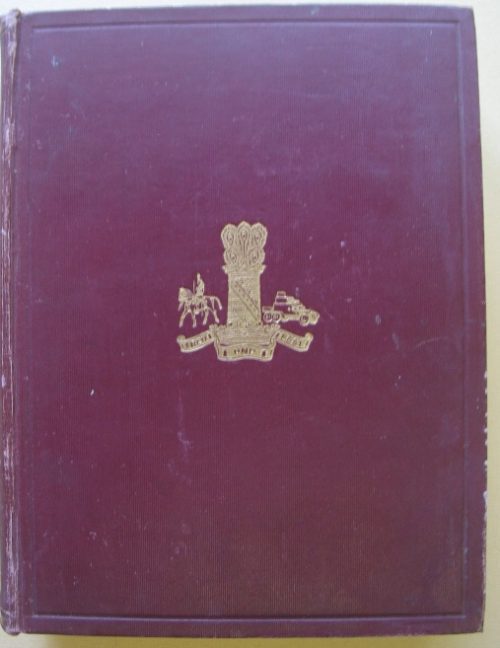Description
Title: History of the Royal Scots Greys (the Second Dragoons)
Author: Pomery, Ralph et al
Condition: Very Good
Edition: 1st Edition
Publisher: N/A
Publication Date: 1928
ISBN: N/A
Cover: Hard Cover without Dust Jacket – 216 pages
Comments: The history of The Scots Greys in France and Flanders, 1914 – 1919. An exceedingly rare title. This copy is a presentation copy to the Royal Scots Greys Officers Mess.
The Scots Greys rotated back into the trenches in 1915. Due t the shortage of infantry, the regiment continued to fill the gaps in the line, fighting in a dismounted role. The regiment remained on line for all but a seven days of the Second Battle of Ypres. The losses in that battle would force the Scots Greys into reserve for the rest of the year.
By January 1916, the Scots Greys were back in action, albeit in a piecemeal fashion. With the Kitchener Armies still not fully ready, men were still needed for the front. Like the other cavalry regiments, the Scots Greys contributed on troop to the front. In two months of action, the line troop supplied by the Scots Greys were active in raids and countering raids by the German army.
With the arrival of the Kitchener Armies, the Scots Greys were concentrated again in preparation of the forthcoming summer offensive. The 2nd Cavalry Division became the reserve for General Plumer’s Second Army. Mounted, the Scots Greys were held in readiness to exploit a breakthrough that never came during the Battle of the Somme.
As the war continued on, it became apparent that more mobile firepower was needed at all levels of the British Army. Accordingly, the Scots Greys were expanded to include a machine gun squadron.
Despite the defeat at the Battle of the Somme, British generals still hoped to use the Scots Greys and other cavalry regiments in their traditional roles. The Battle of Arras would demonstrate the futility of that hope
Beginning in April, the Scots Greys were engaged in action around the town of Wancourt. In three days of fighting, in an action which would become knownas the First Battle of the Scarpe, the regiment suffered heavy casualties among its men and horses. After a short period to refit, the Greys drew the assignment of raiding the German positions at Guillermont Farm. The raid succeeded, with the Scots Greys killing 56 and capturing 14 with negligible loss to themselves.
In November 1917, the Scots Greys saw a glimpse of their future when they moved to support the armoured attack at the Battle of Cambrai. Initially intended to be part of the exploitation force, as at the Battle of the Somme, the plan failed to develop the type of break through which could be exploited by the cavalry. As the fighting bogged down, Scots Greys once again found themselves fighting on foot in an infantry role. Interestingly, part of the reason that the Scots Greys were unable to advance as cavalry was due to the fact that the bridge which was crucial to the advance was accidentally destroyed when the tank crossing it proved to be too heavy. Unable to advance mounted, the Scots Greys were committed as infantry to the battle.
After the winding down of the battles of 1917, the Scots Greys found themselves near the St. Quentin canal. There, they witnessed the German offensive forcing their way across the canal. Although the Scots Greys held their positions, they were soon in danger of being flanked. After almost three years of static warfare, the rapidity of the German advance caught the regiment flat flooted as the German attacks penetrated the Scots Greys position. In the confusion of the retreat, detachments of the Scots Greys became lost and ended up serving with other regiments of the 5th Cavalry Brigade, fighting rearguard actions as the B.E.F. retreated. Once the Michael Offensive began to grind down in April, the Scots Greys, along with the other cavalry regiments were able to be withdrawn from the line to refit and reorganize.
Between May and June 1918, the Scots Greys were held in reserve. However, in August, the Scots Greys was brought forward for the Battle of Amiens. Still part of the 2nd Cavalry Division, the Scots Greys moved in support of the Canadian Corps’ attack on Roye.
With the victory at the Amiens, the B.E.F. began its long awaited final offensive. During this first month of the offensive, August to September 1918, the Scots Greys rarely operated as a unit. Instead, detachments of the Scots Greys were engaged in a variety of traditional cavalry duties. This included scouting, liaison duties and patrolling. As the B.E.F. approached the Sambre river, the Scots Greys were used to probe the available river crossings. However, just as they did, many dragoons of the Scots Greys began to fall ill from influenza. Within a few days, due almost solely to the influenza outbreak, the regiment could muster only one composite company of men healthy enough to fight.
At the time of the Armistice, the Scots Greys were at Avesnes. In order to help enforce the terms of the Armistice, the Scots Greys were ordered to cross into Germany, arriving there on 1 December 1918. However, although they would be here to police the terms of the armistice until a final treaty could be completed, they were almost immediately dismounted. By the beginning of 1919, the Scots Greys were reduced to 7 officers and 126 other ranks. This was approximately the size of one of its pre-war squadrons. After almost five years of service on the continent, the Scots Greys returned home to Britain on 21 March 1919 via Southampton.




